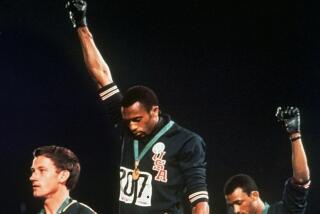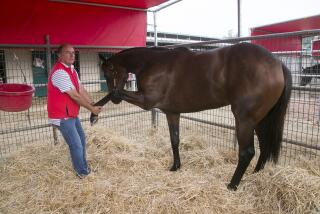Lewis’ Name Arises Again at Inquiry
- Share via
TORONTO — After gaining an international reputation as an expert in the administration of anabolic steroids and other performance-enhancing drugs to track and field athletes, Dr. Jamie Astaphan said he was approached on two occasions last year to work with Carl Lewis and other members of the Santa Monica Track Club.
But Astaphan, whose most famous patient was Lewis’ sprint rival, Ben Johnson, testified Wednesday before the Canadian government’s commission of inquiry into drug use by athletes that he ignored the overtures, which he said were made after meets last August at Ottawa, Canada, and Zurich, Switzerland, by Dr. Jack Scott.
A former sports and political activist best known for his connection with Patty Hearst during her association with the Symbionese Liberation Army, Scott has maintained a high profile in athletics as a physical therapist. He has treated both Lewis and Johnson.
In a telephone interview from his Berkeley office, Scott gave a different version of the story. He said Astaphan approached him after Johnson finished second to Lewis in the 100 meters on Aug. 17 at Zurich and expressed frustration because of the Canadian sprinter’s notoriously lackadaisical work habits.
“Astaphan came up to me and said, ‘Introduce me to Carl,’ ” Scott said. “He said, ‘If I can do for Carl what I’ve done for Ben, it won’t even be close.’ ”
Scott said he did not consider acting upon Astaphan’s request because of “his reputation that he gave out steroids and other illegal drugs.”
Joe Douglas, the Santa Monica Track Club manager, said Scott told him essentially the same story during the Summer Olympics at Seoul last October, when Johnson was disqualified because of his positive test for an anabolic steroid after winning the 100 meters. As the runner-up, Lewis subsequently was awarded the gold medal.
When told of Astaphan’s version, Douglas laughed. “That’s obviously not true,” he said, speaking by telephone from Santa Monica. “Number one, we’re anti-drug. Number two, if anybody is going to approach anybody, it would be me. Jack Scott does not represent the Santa Monica Track Club.”
It was the second time Lewis’ name has emerged in testimony at the inquiry, the track and field phase of which entered its 13th week Wednesday. Johnson’s coach, Charlie Francis, earlier suggested that Lewis might have been part of a plot to sabotage Johnson’s drug test, a theory that since has been discounted by the commission.
Astaphan, who has been working with Canadian athletes since 1983 despite moving his practice almost three years ago to his native Caribbean island of St. Kitts, is expected to shed more light on Johnson’s positive drug test before his testimony ends sometime next week.
But it was his threat to “spill every detail” about drug use in track and field that attracted a large group of reporters and photographers to the downtown office building that has been rented for the hearing.
If Astaphan, who turned 43 Monday, intends to provide significant details, he is saving them for another day. He said an Eastern European athlete who was visiting Toronto in the fall of 1985 traded him 48 bottles of Miotolin, which contains the steroid furazabol, in exchange for 144 bottles of a vitamin mixture concocted by Astaphan. He said the athlete told him that he and his teammates referred to the drug as Estrogol as a diversionary tactic. There is no such drug as Estrogol. “They did not want, quotation marks, the damn Americans to get ahold of it,” Astaphan said.
But Astaphan had to be pressed by the commission’s co-counsel, Robert P. Armstrong, before he would identify the athlete as an East German.
Because he had never heard of furazabol, Astaphan said he consulted Canadian, European and U.S. doctors before prescribing it for the athletes he treated.
When reminded by Armstrong that he was supposed to keep furazabol a secret from the Americans, Astaphan said that he did not consult the two Southern California doctors he believed to be most closely associated with U.S. track and field athletes, Dr. Robert Kerr of San Gabriel and Dr. Walter Jekot, who has offices in Los Angeles, Santa Ana and San Fernando.
Kerr, who is expected to testify next month, has admitted that he treated many Olympic athletes from throughout the world with anabolic steroids and other performance-enhancing drugs before 1984. But it was the first time Jekot’s name has been introduced in testimony. “It’s my understanding that Dr. Jekot is the one most American track and field athletes go to,” Astaphan said.
Jekot, who admitted to having formerly prescribed steroids to athletes, was nevertheless mystified by Astaphan’s comments. “No, I haven’t prescribed anabolics in my practice for the last two years,” Jekot said Wednesday. “When I was prescribing them most of my patients were weightlifters, body builders and football players. I had very few track people. As a matter of fact, I can count them on my hand.”
Jekot said that he had a fairly extensive practice for more than 10 years in which he prescribed steroids to athletes and nonathletes. However, two years ago he was asked by the L.A. County Medical Assn. to halt the practice. Jekot said he has not prescribed the drugs since then.
Astaphan said he began treating athletes with anabolic steroids in October, 1983, after a sprinter, Angella Taylor Issajenko, returned from an appointment in San Gabriel with Kerr. He said Issajenko loaned him a copy of Kerr’s book, which he called “a recipe book for taking steroids.”
Like Kerr, he said he felt bound by the Hippocratic Oath to see that Issajenko and his other patients, once they decided to start on a steroid program, used the drugs without endangering their health. “If they didn’t get it from me, they would get it elsewhere,” Astaphan testified. “They came to me for advice and supervision, and I felt it was my responsibility to get it to them.”
He added that he believes side effects associated with steroid use have been greatly exaggerated.
“Taken in the recommended doses, there are no side effects,” he said.
He named 14 Canadian athletes he treated with steroids. Johnson was the third to start, beginning early in 1984. According to Francis’ testimony, Johnson had been using steroids obtained from other sources since 1981.
Astaphan estimated that he gave Johnson 50 or 60 injections between 1984 and 1988 and said he never doubted the sprinter was aware he was receiving steroids. Johnson, who is expected to testify in mid-June, has said that he never “knowingly” used banned substances.
“He was very inquisitive,” Astaphan said.
But Astaphan said the only time he gave Johnson a drug containing stanozolol, the steroid found in his system at Seoul, was in 1984 or 1985. “After the fifth or sixth day, he wanted to quit because he couldn’t run,” Astaphan said. “He tightened up.”
Astaphan described Johnson as a less-than-ideal patient, testifying that he often did not keep his appointments.
“Ben works by his own timetable,” Astaphan said.
He said Johnson arrived in a training camp at Tallahassee, Fla., in the spring of 1985 without the bottle containing his drug of choice at the time, testosterone, because he had forgotten to take it from Toronto.
It was such behavior, Scott said, that Astaphan complained about when he tried to switch his allegiance last year to Lewis. But that was not Astaphan’s testimony Wednesday.
“Jack Scott approached me in Zurich and said for me to meet with Carl Lewis and the (Santa Monica) group because he said they expressed an interest in working with me,” Astaphan said. “I told him I wasn’t interested.
“He had made the same suggestion in Ottawa, that I work with the Santa Monica group, but I ignored him.”
Times staff writer Julie Cart from Los Angeles contributed to this story.
More to Read
Go beyond the scoreboard
Get the latest on L.A.'s teams in the daily Sports Report newsletter.
You may occasionally receive promotional content from the Los Angeles Times.






